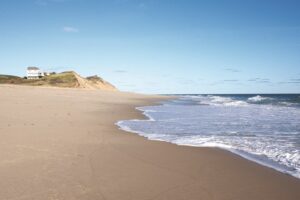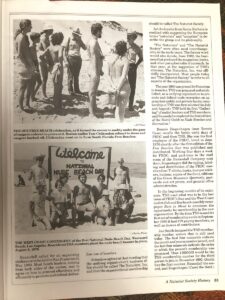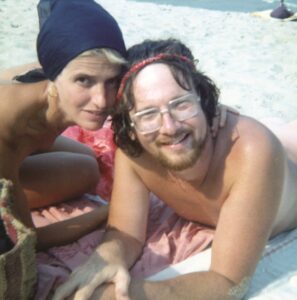TRURO — Fifty years ago, on a stretch of shore known as Brush Hollow, nestled between the ocean and a high dune just south of Ballston Beach, multigenerational throngs gathered on summer days, equipped with surfboards and volleyballs and wearing big-brim hats and, for the most part, nothing else.
“This was raucous nudity,” says Jim Gilbert, a lifeguard at the time who now writes about surf fishing for the Independent. “It was the ’70s. It was a wonderful political act to take your clothes off in public. That was the spirit of the day.”

On duty, Gilbert sported “orange bloomers,” he says. But it was standard for the guards to scamper down to Brush Hollow during their hour-long breaks, strip down, and surf in the nude. “It was not them and us,” Gilbert says. “We were them.”
The scene was not so very different from what it is today. Families congregated and kids rode boogie boards while their parents reclined on shore; boisterous volleyball games punctuated the days. Phineas Baxandall went as a kid. “There was nothing sexualized about the scene,” he says. It was like any happening beach, but bare.
Awkward intrigue was reserved for non-beachgoers.

Karen Dukess, who was 10 or 11 at the peak of the Brush Hollow swell, remembers finding it all “excruciatingly embarrassing.” Dukess is also not the only one who recalls seeing gawkers station themselves on the high dune with binoculars to magnify the bodies down below.
“We had our own flasher, which was ridiculous,” says Lee Elman, a former Brush Hollow bather who lives in Miami now. In an act of irony for the ages, a man, clad literally in a raincoat, Elman says, would stand on the dune and flash the nude beachgoers.
But mostly, Brush Hollow attracted devoted enthusiasts. By 1974, the spot was a destination. Under the headline “Modern Living: The Nudity Problem,” Time magazine reported in July of that year that summery Saturdays on the dunes “reveal 500 bare beach bunnies of all ages.” It went on: “Defying the garment industry, New York vestiphobes are stripping down for a gymnophiliac season in the sun.” Some days, the crowds numbered over 1,000.
Just before Labor Day in 1974, a tragedy led to a new critique of the beach. Because Brush Hollow fell beyond the town-controlled parcel of beach at Ballston, lifeguards were never stationed there. Gilbert, the head Truro lifeguard at the time, was often summoned to Brush Hollow to bandage a bleeding cut or fetch someone who’d fallen asleep on a raft and drifted too far out. But on Sept. 1, 27-year-old Lito Villcorta was found in the water not breathing. Several hundred naked people watched Gilbert take over performing CPR on Villcorta, but he could not be revived.
Although it didn’t expressly respond to the incident, a decision to impose a ban on what had become a nudist mecca came soon after Villcorta’s drowning, following discussions between the Cape Cod National Seashore and the town.
A report prepared by the North Atlantic Regional Office of the National Park Service, supplementing a broader environmental assessment, laid out five ways to address Truro’s “Nude Bathing and Related Concerns.” The report noted that, according to residents, nude bathing was “a blight which has overtaken the town.”
The report called for action to protect the town’s tourism industry, saying that it was important that it “not become blemished through promotion of uses that have the potential of controversy and disruption of existing social patterns.”
By then, however, Brush Hollow had arguably galvanized a whole new social pattern. When the scores of beachgoers began to outnumber even makeshift parking spots, local businesspeople founded a jitney service to shuttle people from the center of town, where the post office is now, to the head of the footpath down to the dunes.
“The issue appears to be not so much the nudists as their numbers, and not so much the numbers of nudists as of their cars parked along the sandy shoulders of the road,” the New York Times reported. The Times also reported the 168-to-48 vote by the town on May 2 to follow through with a nudity ban.
When the “opaque clothing” mandate was imposed on May 19, 1975, Lawrence Hadley, then-superintendent of the National Seashore, warned that five rangers would be patrolling the infamous strip of sand, prepared to make arrests, until early June, when the brigade would be upped to 42.
“Next thing we knew, they had park rangers on motorized tricycles zooming down the dunes,” recalls Ray Elman, Lee’s husband. The uniform-clad rangers issued enough citations to nude beachgoers that he stopped going there nude. Lee remembers instituting a rotating lookout system with the other beachgoers and rushing to wrap herself in a towel when rangers were spotted. “It was a nuisance,” says Ray.

For Phineas’s father, Lee Baxandall, a publisher and antiwar organizer who’d been relishing bare Brush Hollow camaraderie for years, the clothing decree fomented a larger movement. Baxandall was behind the “Free the Free Beach” campaign that began that summer, and the Brush Hollow demonstration of Aug. 23, 1975 that drew thousands, unclothed, once again.
“To him, social nudism was this transcendent way for people to become less alienated from each other,” says Phineas.
None of the 2,500 bare bodies flocking to the shore that day in August received citations, and the uprising was a triumph. “Park rangers and Truro police let the nude bathers, who came in all shapes and sizes, have their day on the beach,” the Cape Codder reported, though Hadley warned that penalties would resume following that special “beach party.”
West Coast free beach activist Eugene Callen called Lee Baxandall with congratulations, and a bare bicoastal collaboration ensued. Free beach advocates partnered to organize a National Nude Weekend, which was held annually nationwide in July starting in 1976.
In 1980, Baxandall held the founding conference of what would become the Naturist Society and published the first edition of the World Guide to Nude Beaches and Recreation that same year. According to a tribute to Baxandall published in the organization’s magazine in 2009, the year after he died, the Seashore’s crackdown in Truro “lit a torch in him that he carried for the remainder of his life.”
What Lee Baxandall was defending wasn’t really so much about being without clothes, says Phineas. It was about having more freedom.
In addition to the organizing, Phineas remembers his dad stirring up peaceful antics with the Seashore: like when he commissioned a Provincetown artist to make swimsuits printed with body parts to keep their wearers looking naked. Rangers would approach them prepared to write a citation only to find that the seemingly nude were in fact perfectly clothed.
In 1975, violations of the Seashore’s opaque clothing decree were punishable by up to $500 or six months in prison. These days, the six-month prison sentence is still the maximum, but the fine for a repeat offense could be as high as $5,000, according to Chief Ranger Mike Valora. The most common penalty by far is a $150 fine, he says, but rangers deal with nudity violations “very, very infrequently.”
In the past five years, just seven people have been charged with “disorderly conduct related to nudity” in the Seashore, he said. Two of those were in Truro.
In the winter, you can amble along the Truro shoreline and spot only seagulls. The waves are thunderous in those months against the chilly silence. Come summer, there will be raucousness: volleyball, hollering kids, but clothed. Still, if you stroll some distance away from the crowds, a wintry remoteness takes over the shore.
And there you may encounter a few who lounge free.
Nowadays, “it’s a quiet nudity,” says Gilbert.



